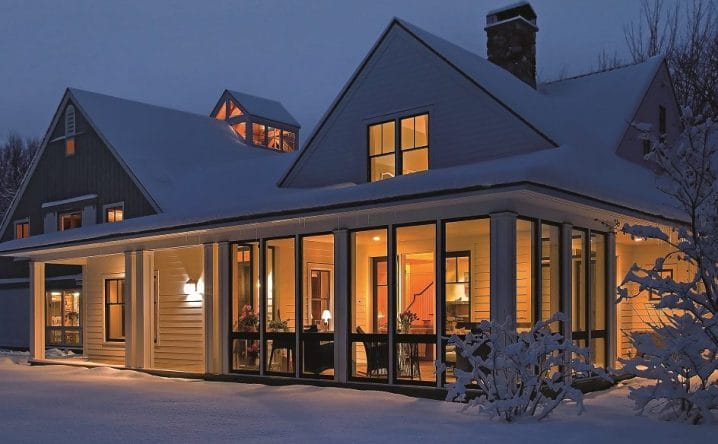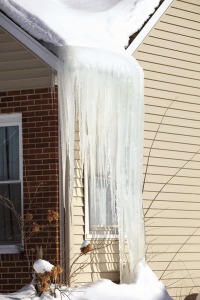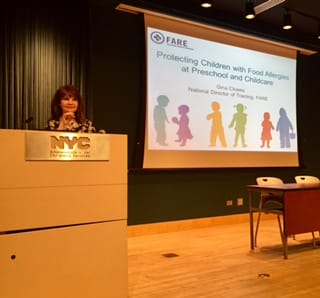 Stay cozy by ensuring your roof and siding are in good repair, and seal windows with a VOC-free sealant. Photo: Rob Karosis: Whitten Architects
Stay cozy by ensuring your roof and siding are in good repair, and seal windows with a VOC-free sealant. Photo: Rob Karosis: Whitten Architects Our guide has helpful advice to winterize your home while keeping allergy and asthma symptoms to a minimum.
For many parts of the country, chilly winter winds are around the corner, and people will soon hunker down indoors for the season. Problem is, when Old Man Winter moves in, he brings conditions that can spell trouble for people with allergies and asthma.
Moisture from rain, snow and ice, if it sneaks indoors, can lead to mold and dust mites; poorly maintained heating systems can bring breathing woes; and, when doors and windows are sealed tight, volatile organic compounds (VOCs) found in everything from flooring to insulation can pack an added punch.
So how best to hold down the fort and keep the air clear until spring returns? Here are some key steps that allergic families can take to winterize the home.
Snow and Wet Bring Mold
Hit the internet or any big box home improvement store and you’ll find an overwhelming array of advice on how to maintain your home, and it can be tough to sort out which tasks are most important as winter sets in.
 Asa Foss
Asa Foss “Most people have no idea what to do, so they pick a few of the easy things and run with those,” says Asa Foss, LEED Residential Technical Director with the U.S. Green Building Council. “But very few people are doing the things they really should be doing to winterize their homes.”
The most crucial thing to remember, he says, is that water is the homeowner’s enemy number one. “With bulk water comes moisture, and with moisture comes mold, mildew, rot, and all of those things that exacerbate people’s problems,” says Foss. “So the most important thing to do is make sure your house is dry.”
Winterize the Home: Roof Repair
Start to winterize your home right at the top. When the rain pours or the snow flies, the last thing you want to be dealing with is a leaky roof. So Foss recommends a careful inspection before winter hits.
Outside, look for staining on the shingles, which is a sign of age, and for shingles that are worn, curling or missing altogether. If it’s plastic, make sure your roof’s flashing, which prevents seepage, isn’t cracking or drying up. Inside your attic, check for any signs of staining, mold or water penetration – and no matter how small those problems are, fix them right away, because they can lead to big headaches.
“The roof takes a lot of abuse, primarily from UV radiation,” says Foss. “The sunlight just beats through materials very quickly.” Also look for any cracks or gaps in your siding, whether it’s wood, vinyl, stucco or another material; if you have brick or stone, keep an eye out for cracks in the mortar.
In the Gutter
 Beware of ice dams, which cause water to back up and damage your shingles and the gutters. Photo: Getty
Beware of ice dams, which cause water to back up and damage your shingles and the gutters. Photo: Getty Gutters may not look particularly important, but they’re an essential tool for keeping moisture away from your home. Problem is, when they get clogged with leaves and debris or they’re broken or disconnected, they can’t do their job. Water can pour down the exterior walls and into your foundation or back up under the shingles.
Foss recommends doing a visual inspection, and either cleaning gutters out yourself or hiring a professional company. This is especially important at the end of the fall if you live near tall trees. If there are damaged gutter sections, repair or replace them without delay.
And most of all as you winterize home gutters, check that the downspouts are draining well away from the house. You can install the most advanced gutter system on the market, but if it’s dumping hundreds of gallons of water right next to your foundation, that moisture can work its way inside – and just one inch’s worth of rain on a 1,000 square-foot roof amounts to a whopping 600 gallons. That’s about 15 bathtubs full, which is no small matter.
“Make sure the gutters are connected, because that may not be a safe assumption,” says Foss, who adds the goal is to keep water as far away from the house as possible. “Make sure your downspouts are pushing water away from your foundation. You’re looking for at least two feet away, and if it can get farther, go farther.”
Winterize the Home Against Ice Dams
If you live in a snowy or icy climate, there’s a good chance you’ve experienced ice dams. These large ridges of ice can form at the edge of your roof. Once there, they’ll damage gutters and cause water to back up into shingles and walls.
Ice dams occur when heat from inside the home travels up into the attic and warms the roof, which causes the snow and ice to melt. That water then trickles down to the edge of the roof, where it hits the gutters and refreezes.
There are systems you can install to melt the ice, but Foss says an ounce of prevention is worth a pound of cure. Hire an insulation expert to seal any air leaks in your attic and increase insulation as needed. It’s a win-win because less heat escapes, which reduces the risk of ice dams, and your home will be warmer and dryer. You’ll see the benefits on your energy bill, too.
Just opt for insulation that doesn’t off-gas formaldehyde or other harmful VOCs; a few favorites include blown-in cellulose (typically made from recycled newsprint), UltraTouch batts (made from recycled blue jeans) and Airkrete, an environmentally friendly foam. Using no- or low-VOC sealants around unfinished basements and garage spaces will also help keep dirtier air from seeping into your living spaces, and sealing around windows and doors will cut down on drafts and leaks.
Foss notes that many of these jobs are best left to the pros. “The devil really is in the details, both with insulation and air sealing. So if you miss some spots and they’re important spots, it negates 90 percent of the work that you’ve done. You’ve really got to do it right,” he says. ‘I’m a huge do-it-yourself proponent, but this is not one of those projects for the vast majority of people.”
Foundation: Check on Ground Slope
So your roof is waterproof, your walls are free of leaks and cracks, your gutters are flowing freely, and your attic is so dry and well-insulated that the heat stands no chance of escape. But don’t think you’re winterized just yet, because there’s one more issue: gravity.
Around the perimeter of the home, soil should slope away from the foundation so rainwater and melting snow are directed away from the home, not toward it.
If your soil is sloping toward your home, getting it graded in the other direction can keep moisture at bay and potentially prevent major home repairs. Grading isn’t always possible, for instance if you live on steep hill. But either way, you want to make sure your drainage system is fully operational.
“If you’ve got a damp basement, very likely the problem is some type of grading issue, and the water is percolating into your basement walls,” says Foss. Yet many people put off grading and foundation work.
“They don’t want to know the scope of damage or the scope of work they need to do. ‘Ignorance is bliss’ is the mantra for a lot of folks,” says Foss. “But the longer you let a water problem fester, the more the damage there is going to be. So you’ve got to get on it.”
Also prune back trees or shrubs near the home; they encourage moisture, and can damage roofs, windows and siding.
Clearing the Air
The other item you don’t want to ignore is your air system, which is meant to keep you cozy – but can also keep you breathing easy.
If you have a furnace, have it serviced by a professional at least every few years. There are different schools of thought on how necessary duct cleaning is (dust mites don’t fare well in that kind of hard, dry environment). Still, most pros agree that it’s a good idea if you’ve been doing renos, have pets, or there is mold in the house.
Changing the furnace filter – or the filters on any air-cleaning system you have – is also essential, and you want to do this monthly in winter. For furnaces, choose a filter with a MERV rating of 11 to 13.
(If you have a whole-home filtration system, consult the manufacturer’s instructions to find out when to change filters.)
However, those filters won’t do much good if dust, mold, VOCs or other pollutants from inside your walls, basement or attic spaces are getting pulled into your air ducts en route to your vents – which can happen if those ducts aren’t properly sealed. So also regularly check exposed ducts for breaks or leaks, or call a pro to test the ducts you can’t see.
Just don’t use duct tape to seal them, says Foss. “Ironically, you can use duct tape for pretty much everything except sealing ducts,” he says with a laugh. “It’s not airtight, so it won’t prevent air leaks.”
Finally, check that your dryer vent is clean and clear, because if it gets clogged, it pushes warm, moist air back into your home – which is exactly what dust mites and mold love – and presents a fire hazard.
Winterize with Home Cleanup
Phil Kean agrees that homeowners should do a thorough inspection of their homes and make necessary fixes before winter descends. Kean, a green-certified architect and luxury home builder who serves on the National Association of Home Builders suppliers’ council, also recommends hiring a home inspector to come through and help pinpoint problems.
 Phil Kean
Phil Kean “When you buy a house, you have a home inspector, but you can also hire them to go through your home and check for all of these things,” he says from his Florida office. “They can usually tell you how much repairs will cost, too.”
People need to carefully consider the chemicals they’re bringing into their homes, from sofas to cleaning products, emphasizes Kean, and opt for items that don’t emit high levels of VOCs. He also recommends avoiding ventless fireplaces that burn fuel (electric units are fine) because the combustion chemicals can reduce indoor air quality. Otherwise you could end up socked in for the winter with a host of harmful compounds that can trigger asthma and other reactions.
For the same reason, he suggests doing a pre-winter cleaning that includes blankets, bedding, shelving and more to get rid of dust mites, mold spores and other substances that can spell trouble – especially when your home is tightly sealed for the season.
“The more you can get out before you close things up, the better off you are,” says Kean. He adds that hiring a residential cleaning service to do a top-to-bottom clean a couple times a year is money well spent. Just make sure they use asthma-friendly cleaning products. “You’ll have less dander and less dust; everything should be wiped down before you shut it all in.”
But more than anything, emphasizes Foss, you want to start outside your home, and prevent problems such as mold and rot, which affect the health of both your family and your home, before they take hold.
“What we really want people to do is keep that stuff out. Don’t deal with it once it’s in the house,” he says. “Figure out where the bad things are coming from and winterize your home to keep them out.”
Read more Healthy Home articles:
Laying Down the Best Allergy-Friendly Flooring Choices
Four Healthy Homes Where Superb Design Also Offers Better Breathing
Creating the Better Baby Nursery: Out With Allergens and VOCs





